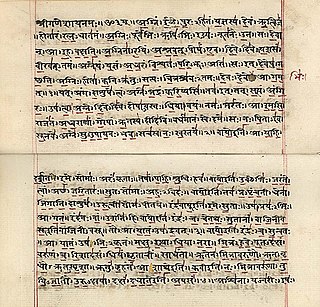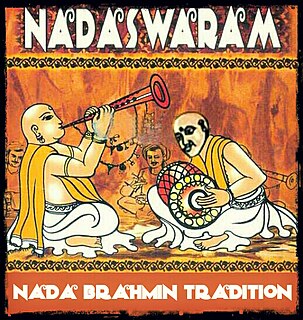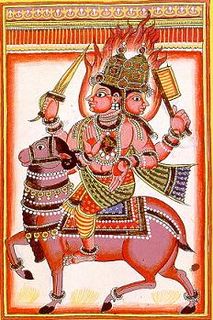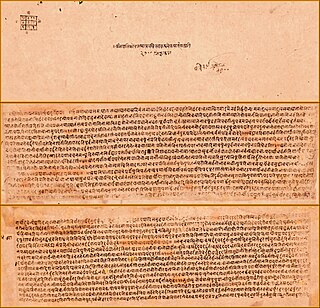
Rishi is a Vedic term for an inspired poet of hymns from the Vedas. Post-Vedic tradition of Hinduism regards the rishis as "Jogi", "great sadhus" or "sages" who after intense meditation (tapas) realized the supreme truth and eternal knowledge, which they composed into hymns.

Om, also written as 'Aum', is the most sacred syllable, symbol, or mantra in Hinduism, that signifies the essence of the ultimate reality, consciousness or Atman. The Om sound is the primordial sound, and is called the Shabda-Brahman. It is a syllable that is chanted either independently or before a mantra. It is also found in Jainism, Buddhism, and Sikhism.
Shruti or Shruthi in Sanskrit means "that which is heard" and refers to the body of most authoritative, ancient religious texts comprising the central canon of Hinduism. It includes the four Vedas including its four types of embedded texts—the Samhitas, the Brahmanas, the Aranyakas and the early Upanishads.

The Brahmanas are a collection of ancient Indian texts with commentaries on the hymns of the four Vedas. They are a layer or category of Vedic Sanskrit texts embedded within each Veda, and form a part of the Hindu śruti literature. They are primarily a digest incorporating myths, legends, the explanation of Vedic rituals and in some cases speculations about natural phenomenon or philosophy.

The Gāyatrī, also known as the Sāvitrī mantra, is a highly revered mantra from the Rig Veda, dedicated to Savitr, the sun deity. Gāyatrī is the name of the Vedic meter in which the verse is composed. Its recitation is traditionally preceded by oṃ and the formula bhūr bhuvaḥ svaḥ, known as the mahāvyāhṛti, or "great (mystical) utterance". Vishvamitra is said to have created the Gayatri mantra.

The Vedas are a large body of religious texts originating in ancient India. Composed in Vedic Sanskrit, the texts constitute the oldest layer of Sanskrit literature and the oldest scriptures of Hinduism. Hindus consider the Vedas to be apauruṣeya, which means "not of a man, superhuman" and "impersonal, authorless".
Vyākaraṇa refers to one of the six ancient Vedangas, ancillary science connected with the Vedas, which are scriptures in Hinduism. Vyākaraṇa is the study of Sanskrit.

Rajnarayan Basu (1826–1899) was an Indian writer and intellectual of the Bengal Renaissance. He was born in Boral in 24 Parganas and studied at the Hare School and Hindu College, both premier institutions in Kolkata, Bengal at the time. A monotheist at heart, Rajnarayan Basu converted to Brahmoism at the age of twenty. After retiring, he was given the honorary title of Rishi or sage. As a writer, he was one of the best known prose writers in Bengali in the nineteenth century, writing often for the Tattwabodhini Patrika, a premier Brahmo journal. Due to his defence of Brahmoism, he was given the title "Grandfather of Indian Nationalism"

The Rigveda is an ancient Indian collection of Vedic Sanskrit hymns along with associated commentaries on liturgy, ritual and mystical exegesis. It is one of the four sacred canonical texts (śruti) of Hinduism known as the Vedas.

The dictionary gives the meaning of the Sanskrit or Tamil expression, Sutram (सूत्रम्) or Sutra (सूत्र), as string or thread, formula, short sentence or aphoristic rule, girdle, stroke, yarn or plan. Unique to Sanskrit literature, Tamil literature and Pali literature of Hinduism, Jainism and Buddhism, they are short cryptic sentences, methodically written as memory-aids, stringing step by step a particular topic or text in its entirety. There are hundreds of Sanskrit texts found written in the Sutra-format such as Kapila Sutram, Samkhya-pravachana Sutram, Brahma Sutra, Jaimini Sutram, Tatvartha Sutram, Kalpa Sutra, etc.

Shabda Brahman or Sabda-brahman or Nada brahmin means transcendental sound or sound vibration or the transcendental sound of the Vedas or of Vedic scriptures.
Dhi, this Sanskrit word means 'understanding', 'reflection', 'religious thought', 'mind', 'design', 'intelligence', 'opinion', 'meditation', 'imagination', 'notion', 'intellect', This word is directly connected with the word, Vāc meaning Speech, derived from Vac meaning, 'to speak'. Dhi is the voiced Vāc or 'Speech', it is the thought-mind or intellect. Dhi also means 'to hold' or 'to place', and indicates the activity of the intellect.
Idam(Tamil) is a Tamil/Sanskrit word which denotes location or position or place. In grammar it is used at the beginning or middle of a sentence as a nominative or attributive pronoun, combined with or without ya, adds emphasis to other nouns, propositions etc.; and means - this, here or yonder, present or seen nearby, fit for, or without reference to noun refers to एतद् ('that') or to what precedes.
Tyāga is a Sanskrit word that means "sacrifice, giving up in generosity, forsaking, resigning" anything of value, as well as "renunciation" depending on the context. It is an ethical concept in Hinduism and Jainism.
Prajña or Pragya as प्रज्ञा, प्राज्ञ and प्राज्ञा is used to refer to the highest and purest form of wisdom, intelligence and understanding. Pragya is the state of wisdom which is higher than the knowledge obtained by reasoning and inference.
vishva' or viśva (Sanskrit:विश्व), root विश् ("vish") means – all, whole, entire, universal, every, everyone, all-pervading, omnipresent. It is another name for Vishnu and also refers to the world, the universe. In literature, this word refers to the entire enchanted universe.

Agni is a Sanskrit word meaning fire, and connotes the Vedic fire god of Hinduism. He is also the guardian deity of the southeast direction, and is typically found in southeast corners of Hindu temples. In the classical cosmology of the Indian religions, Agni as fire is one of the five inert impermanent constituents (Dhatus) along with space (Akasha/Dyaus), water (Jal), air and earth (Prithvi), the five combining to form the empirically perceived material existence (Prakriti).















